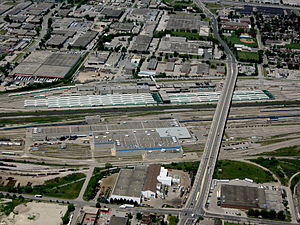
GO Transit is a regional public transit system serving the Greater Golden Horseshoe region of Ontario, Canada. With its hub at Union Station in Toronto, GO Transit's green and white commuter rail trains and coach-style buses serve a population of more than seven million across an area over 11,000 square kilometres (4,200 sq mi) stretching from London in the west to Peterborough in the east, and from Barrie in the north to Niagara Falls in the south. In 2021, the system had a ridership of 13,579,400. GO Transit operates diesel-powered double-decker trains and coach buses, on routes that connect with all local and some long-distance inter-city transit services in its service area.

Union Station is a major railway station and intermodal transportation hub in Toronto, Ontario, Canada. It is located on Front Street West, on the south side of the block bounded by Bay Street and York Street in downtown Toronto. The municipal government of Toronto owns the station building while the provincial transit agency Metrolinx owns the train shed and trackage. Union Station has been a National Historic Site of Canada since 1975, and a Heritage Railway Station since 1989. It is operated by the Toronto Terminals Railway, a joint venture of the Canadian National Railway and Canadian Pacific Railway that directs and controls train movement along the Union Station Rail Corridor, the largest and busiest rail corridor in Canada.

Lakeshore West is one of the seven train lines of the GO Transit system in the Greater Toronto Area, Ontario, Canada. It extends from Union Station in Toronto to Hamilton, with occasional trips extending to St. Catharines and Niagara Falls.
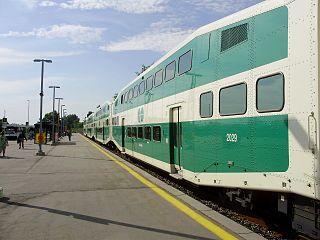
Barrie is one of the seven train lines of the GO Transit system in the Greater Toronto Area, Ontario, Canada. It extends from Union Station in Toronto in a generally northward direction to Barrie, and includes ten stations along its 101.4 kilometres (63.0 mi) route. From 1982 to 1990 and again from 1993 to 2007, it was known as the Bradford line, named after its former terminus at Bradford GO Station until the opening of Barrie South GO Station.
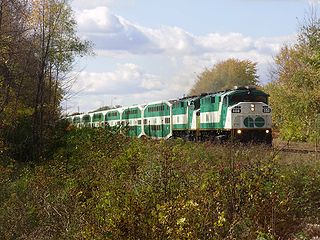
Lakeshore East is one of the seven commuter rail lines of GO Transit in the Greater Toronto Area, Ontario, Canada. It extends from Union Station in Toronto to Oshawa GO in Durham Region. Buses from Oshawa connect to communities further east in Newcastle, Bowmanville and Peterborough.

Malton GO Station is a train and bus station in the GO Transit network, located near Toronto Pearson International Airport, in the community of Malton in Mississauga, Ontario, Canada. It is a stop on the Kitchener line, and is a flag stop for Via Rail trains operating between Toronto, London and Sarnia.

Mimico GO Station is a railway station in the GO Transit network located in the Etobicoke area of Toronto, Ontario, Canada. It is a stop on the Lakeshore West line train service, serving the Mimico neighbourhood.
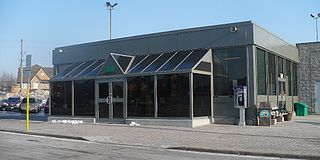
Rouge Hill is a GO Transit train and bus station on the Lakeshore East line. The station is located on the shore of Lake Ontario in West Rouge in the former municipality of Scarborough, the most easterly neighbourhood of Toronto, Ontario, Canada. It is a major commuter transfer point, with large parking lots and local bus services. It is the last station in Toronto before the trains enter Durham Region.

Durham College Oshawa GO station is a station for commuter rail, passenger rail and regional bus services in Oshawa, Ontario, Canada. It is the terminal station for the Lakeshore East line of GO Transit and serves Via Rail's Corridor service, which travels from Toronto to both Ottawa and Montreal. The bus terminal is served by bus routes of GO Transit and Durham Region Transit.

Kitchener station is a railway station located in Kitchener, Ontario, Canada, slightly to the northeast of downtown Kitchener, at 126 Weber Street West, near the corner of Victoria Street. It is a heritage building containing a waiting room and ticket counter built beside a set of tracks also used as a freight yard. A separate building to the east of the passenger area, originally built in 1925 as a freight building, now serves as the headquarters for the Goderich–Exeter Railway.

Metrolinx is a Crown agency of the Government of Ontario that manages and integrates road and public transport in the Greater Toronto and Hamilton Area (GTHA), which comprises much of Ontario's Golden Horseshoe region. Headquartered at Union Station in Toronto, the agency was created as the Greater Toronto Transportation Authority on June 22, 2006. The agency adopted its present name as a brand name in 2007 and eventually as the legal name in 2009.
Line 6 Finch West, also known as the Finch West LRT, is a light rail line under construction in Toronto, Ontario, Canada, to be operated by the Toronto Transit Commission. The 10.3-kilometre (6.4 mi), 18-stop line is to extend from Finch West station on Line 1 Yonge–University to the North Campus of Humber College in Etobicoke. Unlike most of the Toronto streetcar system, the line will be segregated from traffic. As well, it will use transit signal priority and standard gauge rather than the broad Toronto gauge. The line is forecast to carry about 14.6 million rides a year or 40,000 a day by 2031. The line will replace the 36 Finch West bus route, which is one of the three busiest bus routes in Toronto. The line is scheduled for completion in 2023, with an estimated cost of $2.5 billion.

The CN Halton Subdivision is a major railway line in Southern Ontario, Canada. It is owned and operated by the Canadian National Railway (CN).
GO Transit is an interregional public transit system in Southern Ontario, Canada, operated by the provincial crown agency Metrolinx. It primarily serves the conurbation referred to by Metrolinx as the "Greater Toronto and Hamilton Area" (GTHA) with operations extending to several communities in the area centred around Toronto and Hamilton.
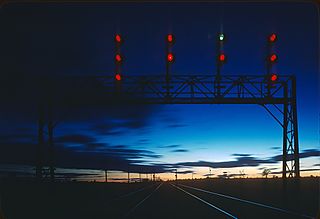
Canadian National Railway's Kingston Subdivision, or Kingston Sub for short, is a major railway line connecting Toronto with Montreal that carries the majority of CN traffic between these points. The line was originally the main trunk for the Grand Trunk Railway between these cities, although there has been some realignment of the route between these cities. The majority of the Kingston Sub runs close to the northern bank of Lake Ontario and the Saint Lawrence River.

Via Rail's Toronto Maintenance Centre is a railway yard in the western end of Toronto, which stores and services Via trains. It lies within the south side of the former CN Mimico Yard directly opposite of the Willowbrook Rail Maintenance Facility on the north side; GO Transit's Lakeshore West line separates the two facilities. The yard is bisected by the Islington Avenue flyover bridge. Its main entrance is located at 50 Drummond Street on the eastern side with a secondary entrance on its southern side along New Toronto Street at Eighth Street.

The Union Station Rail Corridor (USRC) is a corridor of railway tracks that exist through and adjacent to Union Station in downtown Toronto. It is 6.4 kilometres long, approximately stretching from Bathurst Street in the west to the Don River in the east, making it the largest rail passenger facility in Canada.

GO Transit rail services are provided throughout the Greater Toronto and Hamilton Area (GTHA) and the Greater Golden Horseshoe. The GO Transit rail fleet consists of 90 MPI MP40 locomotives and 979 Bombardier BiLevel Coaches. In 2021, the system had a ridership of 8,979,300 passengers per year.

The Canadian National Railway Bala Subdivision is a major railway service line in Ontario running between the provincial capital of Toronto in Southern Ontario and Capreol in Northern Ontario, where the line continues as the Ruel Subdivision. It forms part of CN's transcontinental mainline between Southern Ontario and Western Canada.
The Whitby Rail Maintenance Facility is a GO Transit rolling stock maintenance facility in Whitby, Ontario, Canada. The depot lies between Victoria Street East and GO Transit's Lakeshore East line just east of South Blair Street. It is a secondary depot, the primary depot being the Willowbrook Rail Maintenance Facility along GO Transit's Lakeshore West line.
